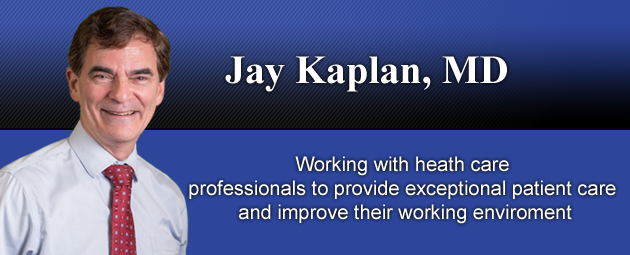By Camilla Rockwell
One of the health care industry’s biggest concerns these days is the state of its paid caregivers: stressed and unhappy. Jay Kaplan, MD, Medical director for the Studer Group, works directly with this problem. In addition to the clinical practice of medicine, he counsels hospitals and physicians nationwide about improving their services.
Kaplan speaks about and embodies the changes he wishes to inspire in others. “What people are search for,: he says, “is connection in a culture that focuses on doing.” Referring to the work of Harold Kushner, Kaplan point out that we tend to recognize only two basic acts: the Achieve Act (doing, accomplishing) and the Connect Act (being in a relationship, relaxing, connecting to oneself). We see these as sequential-first one achieves, then one connects. But in a healing environment, he maintains, “connect comes first:.
With a patient or an audience, Kaplan knows that the energy he convey create connection more than his words. So he gears up for his presentations by taking a run or moving to music. Thought he speaks without notes, he keeps reminders in front of him: BREATE-CONNECT- THE FOCUS IS NOT ON YOU – HAVE FUN. “When we’re nervous,” he observes, “we focus on ourselves rather than on our listeners. When anxious we stop breathing.” By taking time to center himself Kaplan becomes more alert and responsive to his audience.
Health professionals, he believes, need to serve themselves as well as their patients, colleagues and families. Challenging them to think beyond just getting through the day, he asks what I means to thrive. “I ask how many of them can pump their fist at the end of the day and say ‘YES, it was a great day!'”
Kaplan believes the key to happiness lies in cultivation an inner life. To inspire his own imagination, he takes quiet time, amidst family and work responsibilities, to write poetry. Leadership is a recurring theme.
Another is versatility. Doctors, Kaplan says, then to use the same style with every patient. He thinks they’d be more effective by adapting their approach to each situation. The inspiration for his own versatility is a form of movement he studied with dancer and author, Gabrielle Roth. Movement practices, he finds, awaken a sensitivity that enables him to connect more easily with his patients.
Someday he hopes to write a book about healing in America. “There’s a lot of treatment going on,” he contents, “but not a lot of healing. Healing requires connection.” Kaplan envisions all our institutions as potential instruments for healing. “A service station man,” he insists, “can be a healer.”

